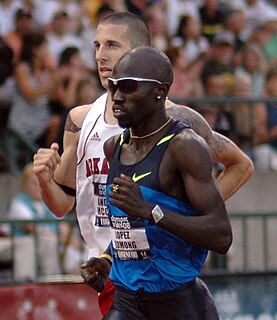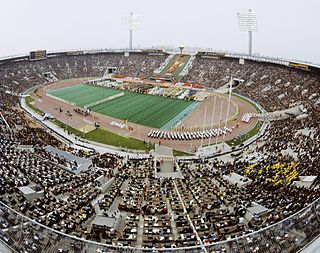
Track and field is a sport that includes athletic contests based on running, jumping, and throwing skills. The name is derived from where the sport takes place, a running track and a grass field for the throwing and some of the jumping events. Track and field is categorized under the umbrella sport of athletics, which also includes road running, cross country running, and racewalking.
1985 in sports describes the year's events in world sport.

USA Track & Field (USATF) is the United States national governing body for the sports of track and field, cross country running, road running and racewalking. The USATF was known between 1979 and 1992 as The Athletics Congress (TAC) after its spin off from the Amateur Athletic Union (AAU), which governed the sport in the US through most of the 20th century until the Amateur Sports Act of 1978 dissolved its responsibility. Based in Indianapolis, USATF is a non-profit organization with a membership of nearly 130,000. The organization has three key leadership positions: CEO Max Siegel, Board of Directors Chair Steve Miller, and elected President Vin Lananna.

Stanford Stadium is an outdoor athletic stadium in Stanford, California, on the campus of Stanford University. It is the home of the Stanford Cardinal college football team as well as the site of the university's commencement exercises. It opened in 1921 as a football and track and field stadium, an earthen horseshoe with wooden bleacher seating and flooring upon a steel frame. Its original seating capacity was 60,000, which grew to 89,000 by 1927 as a nearly enclosed bowl. Immediately following the 2005 season, the stadium was demolished and rebuilt as a dual-deck concrete structure, without a track. Today, it seats 50,424.

The United States of America (USA) has sent athletes to every celebration of the modern Olympic Games with the exception of the 1980 Summer Olympics, during which it led a boycott to protest the Soviet invasion of Afghanistan. The United States Olympic & Paralympic Committee (USOPC) is the National Olympic Committee for the United States.

The United States of America has sent athletes to every celebration of the modern Summer Olympic Games with the exception of the 1980 Summer Olympics, during which it led a boycott. The United States Olympic & Paralympic Committee (USOPC) is the National Olympic Committee for the United States.

The Friendship Games, or Friendship-84, was an international multi-sport event held between 2 July and 16 September 1984 in the Soviet Union and eight other socialist states which boycotted the 1984 Summer Olympics in Los Angeles.
Payton Jordan was the head coach of the 1968 United States Olympic track and field team, one of the most powerful track teams ever assembled, which won a record twenty-four medals, including twelve golds. He was born in Whittier, California. Jordan was exceedingly successful as a collegiate track coach for a decade at Occidental College and for 23 years at Stanford University. A star three-sport athlete in his youth, Jordan more recently became one of the most dominant track athletes of all time, as a sprinter, in senior divisions. Jordan died of cancer at his home in Laguna Hills, California on February 5, 2009.
The Pacific Conference Games were a quadrennial athletics competition, held between 1969 and 1985 and contested by Australia, Canada, Japan, New Zealand and the United States. Each of the five nations hosted an edition of the competition before its dissolution in 1985. The 1981 and 1985 events were open to athletes from all nations.

The Diamond League is an annual series of elite track and field athletic competitions comprising fourteen of the best invitational athletics meetings. The series sits in the top tier of the World Athletics one-day meeting competitions.

The United States Olympic Trials for the sport of track and field is the quadrennial meet to select the United States representatives at the Olympic Games. Since 1992, the meet has also served as the year's USA Outdoor Track and Field Championships. Because of the depth of competition in some events, this has been considered by many to be the best track meet in the world. The event is regularly shown on domestic U.S. Television and covered by a thousand members of the worldwide media. As with all Olympic sports, the meet is conducted by the national governing body for the sport, currently USA Track & Field (USATF), which was previously named The Athletics Congress (TAC) until 1992. Previous to the formation of TAC in 1979, the national governing body for most sports was the Amateur Athletic Union (AAU).
The IAAF Grand Prix was an annual, global circuit of one-day outdoor track and field competitions organized by the International Association of Athletics Federations (IAAF). It was created in 1985 as the IAAF's first seasonal track and field circuit and lasted until 2009. Athletes scored points based on their performances on the circuit and the top athletes were invited to the annual IAAF Grand Prix Final.

The men's high jump field event at the 1960 Olympic Games took place on September 1. Thirty-two athletes from 23 nations competed. The maximum number of athletes per nation had been set at 3 since the 1930 Olympic Congress. The event was won by Robert Shavlakadze of the Soviet Union, the nation's first victory in the men's high jump. Valery Brumel took silver; both men surpassed the previous best placing for the Soviet team of bronze. American John Thomas took bronze to keep alive the United States' streak of medaling in every edition of the Olympic men's high jump.

The Oregon Ducks track and field program is the intercollegiate track and field team for the University of Oregon located in the U.S. state of Oregon. The team competes at the NCAA Division I level and is a member of the Pac-12 Conference. The team participates in indoor and outdoor track and field as well as cross country. Known as the Ducks, Oregon's first track and field team was fielded in 1895. The team holds its home meets at Hayward Field in Eugene, Oregon. Robert Johnson is the current head coach and since the program's inception in 1895, there have only been seven permanent head coaches. The Ducks claim 32 NCAA National Championships among the three disciplines.

The IAAF Golden Events were a sporadic series of twelve athletics events organised by the International Amateur Athletics Federation (IAAF) from 1978 to 1982. Aside from the inaugural event in Tokyo, the contests were held in Europe and were attached to independent track and field meetings. The purpose of the events was to raise the profile of the sport outside of Olympic competition. Marking the growing professionalism in athletics, a significant prize pot was given to the winner of the event – a move designed to attract the sport's top athletes to compete against each other at the same meeting. The inaugural prize was an 18-carat gold trophy worth 9,500 US dollars. All twelve events were for men, reflecting their position as the most prominent sex during that period.

The Soviet Athletics Championships was an annual outdoor track and field competition organised by the Soviet Athletics Federation, which served as the Soviet national championship for the sport.
The 1958 USA–USSR Track and Field Dual Meet was an international track and field competition between the Soviet Union and the United States. The first in a series of meetings between the nations, it was held in 27 and 28 July in Moscow and finished with Soviet Union beating the United States 172:170. The meet marked an unusual head-to-head for the nations during the Cold War.
The 1959 USA–USSR Track and Field Dual Meet was an international track and field competition between the Soviet Union and the United States. The second in a series of meetings between the nations, it was held on July 18–19 in Philadelphia, United States, and finished with Soviet Union beating the United States 175 to 167. The meet marked an unusual head-to-head for the nations during the Cold War. The men's 10,000 meters drew attention as the American competitor Bob Soth collapsed in the heat mid-race – an event which was filmed and presented in the Soviet documentary Sport, Sport, Sport.

The 1961 USA–USSR Track and Field Dual Meet was an international track and field competition between the Soviet Union and the United States. The third in a series of meetings between the nations, it was held on July 15–16 in Lenin Stadium, Soviet Union, and finished with Soviet Union beating the United States 179 to 163. A total of 33 events were contested, 22 by men and 10 by women.

The 1962 USA–USSR Track and Field Dual Meet was an international track and field competition between the Soviet Union and the United States. The fourth in a series of meetings between the nations, it was held on July 21–22 at the Stanford Stadium in Stanford, California, United States, and finished with the Soviet Union beating the United States 173 to 169. A total of 32 events were contested, 22 by men and 10 by women. The meet marked a high point in public interest in the competition, with an attendance of more than 150,000 over the two-day event – the largest ever on a non-Olympic track and field competition. Even the Soviet workouts attracted crowds of 5000.













